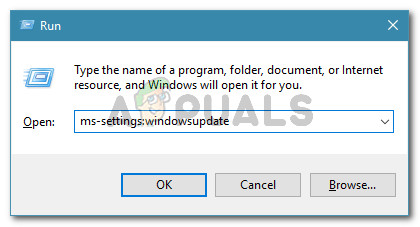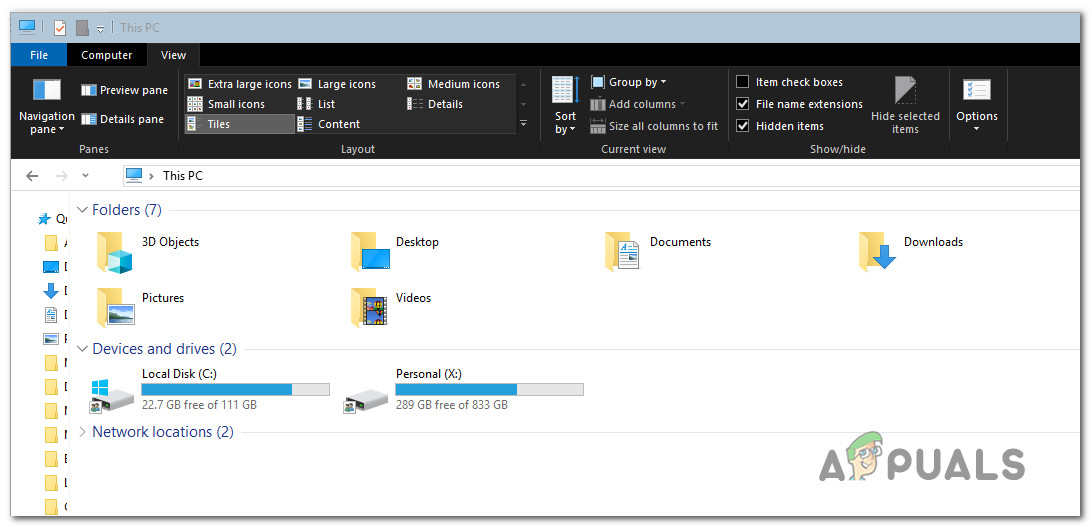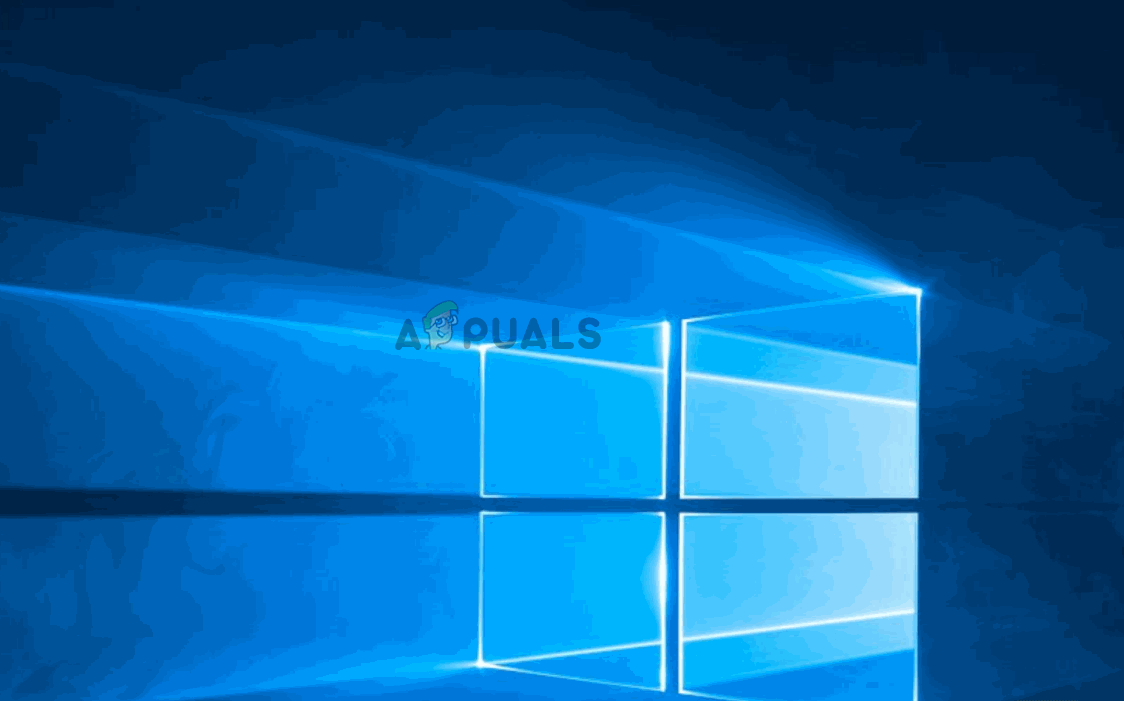Fix: File Explorer Dark Theme Not Working on Windows
More and more people are reporting that the dark theme on File Explorer no longer works on Windows 10. Some affected users have reported that the theme used to work but after an update it no longer does, while others say that they never figured out how to make the theme usable. A couple of users are reporting that in their case, the dark theme is only enforced partially (some menus are still white)

What is causing the Dark Theme to stop working on Windows 10?
We investigated this particular issue by looking into various user reports and the fixes that they themselves used to get to the bottom of this problem. As it turns out, there are several common culprits that are known to break the functionality of the Dark Theme on Windows 10:
- Outdated Windows version – In most case, the dark theme will not function as intended due to various bugs and glitches that were present in the beta release of the dark theme, but where since patched by Microsoft. If you want an easy way to fix the issue, then updating your Windows build to the latest version available and installing all pending updates will most likely resolve the problem.
- Mach2 or other similar tool breaks the legitimate dark mode – If you used Mach2 or a similar tool to install Dark theme back when it was only available for insider builds, you might be experiencing issues now that the feature has been released for all users. In this case, you can either clean install or run a command to re-enable the theme via the 3rd party app.
- Dark theme glitch – There is one glitch that seems to persist despite the various updates that Microsoft released on this matter. If you’re suffering from the bug that makes the File Explore menu only partially dark, you’ll be able to resolve the issue by either applying the default theme and using the standard background image or by re-applying the dark mode a couple of times.
If you’re currently struggling to resolve the same problem, this article will provide you with a few troubleshooting guides that other users in a similar situation have successfully used to get the dark theme working on their Windows 10 computers.
The methods below are ordered by difficulty and efficiency, so we encourage you to follow them in the order that they are presented.
Method 1: Update your Windows 10 build to the latest version
One of the first things you should try if you’re encountering this issue is to update your Windows 10 build to the latest version. Keep in mind that the Dark theme was released a beta version for a lot of Windows 10 builds. It was known to contain a lot of bugs and glitches that made the experience less than pleasant.
However, the theme has since matured and it’s now almost bug-free. But in order to get the latest version available, you’ll need to make sure that your Windows 10 OS contains the latest updates. Here’s a quick guide on how to do this:
- Press Windows key + R to open up a Run dialog box. Then, type “ms-settings:windowsupdate” and press Enter to open up the Windows Update screen of the Settings app.

Run dialog: ms-settings:windowsupdate - Inside the Windows Update tab, click on Check for Updates, then follow the on-screen prompts to install every pending update until there are none left.

Checking for Updates – Windows Update Note: If prompted to restart when you’re still having some pending updates, do so as instructed and return to this screen once the next startup is complete to complete the update installations.
- Once every update is installed, try to mount the Dark Theme again and see if it’s working as intended.
If it’s not, move down to the next method below.
Method 2: Using Mach2 to enable Dark Theme (if applicable)
If you previously used the mach2 tool in order to get the black theme without updating your Windows 10 build to the latest version, you can’t repair it conventionally if a new update kicked in.
However, there is one command that you can run inside Command Prompt that will re-enable the Dark theme. But keep in mind that the Dark theme that you’ll end up using, in this case, is not the latest and is prone to contain errors and glitches.
If this scenario is applicable to your situation, here’s a quick guide on how to resolve the issue if you use the Mach2 tool:
- Navigate to the location of the mach2 folder and type “cmd.exe” in the address bar. This will open a Command Prompt directly in the location that is of interest to us.

Opening a Command Prompt in the mach2 folder Note: if you no longer have the mach2 tool on your computer, use these links to re-download it: 32-bit (here), 64-bit (here). Once it’s downloaded, extract it with a utility and paste it wherever you want, but make sure all files are included in a single folder.
- Inside the newly opened Command Prompt, type the following command and press Enter:
mach2 enable 10397285
- If the procedure is successful, you’ll get a success message ‘OK’.
- Restart your computer and reactivate the theme by going to Settings > Personalization > Colors and set the default app mode to Dark.
If this method wasn’t applicable or didn’t allow you to resolve the issue, move down to the next potential fix below.
Method 3: Reapplying the wallpaper
Some users that have been encountering a weird issue where only half of the File Explorer is actually dark have managed to resolve the issue by accessing the active theme settings and applying the wallpaper again. This might seem like a random step, but a lot of users have reported that they were able to resolve the issue indefinitely after doing this.

Here’s what you need to do to fix this is if this scenario is applicable:
- Press Windows key + R to open up a Run dialog box. Then, type “ms-settings:themes” and press Enter to open up the Themes tab of the Settings app.

Run dialog: ms-settings:themes - Select the Windows theme (NOT the Windows 10 theme), click on Background and select one of the default wallpapers of that theme.

Re-applying the default Windows theme - As soon as the wallpaper is re-applied, you should get the Dark theme back in full mode.
If this method didn’t allow you to resolve the Dark theme issue, move down to the next method below.
Method 4: Re-applying the Dark Mode
If you’ve come this far without a result, it’s very likely that the issue is occurring due to a well-known glitch that will prevent the Dark theme from showing up on File Explorer. Several users that have been encountering the very same symptom have managed to get the issue resolved by re-applying the dark mode (once or twice).
Here’s a quick guide on how you can re-apply the Dark Mode in order to resolve the dark theme issue on Windows 10:
- Press Windows key + R to open up a Run dialog box. Then, type “ms-settings:colors” and press Enter to open up the Colors tab of the Personalization Settings menu.
- Inside the Colors tab, scroll down to the More options section and change the Default app mode back to Light and restart your computer.
- Once the next computer startup is complete, return to the Colors menu, and change the Default app mode back to Dark.
- Open File Explorer and see if the issue has been resolved.

Note: if the File Explorer is still glitched and doesn’t display the dark theme, repeat the procedure about one more time, but this time don’t perform a restart at step 2.





